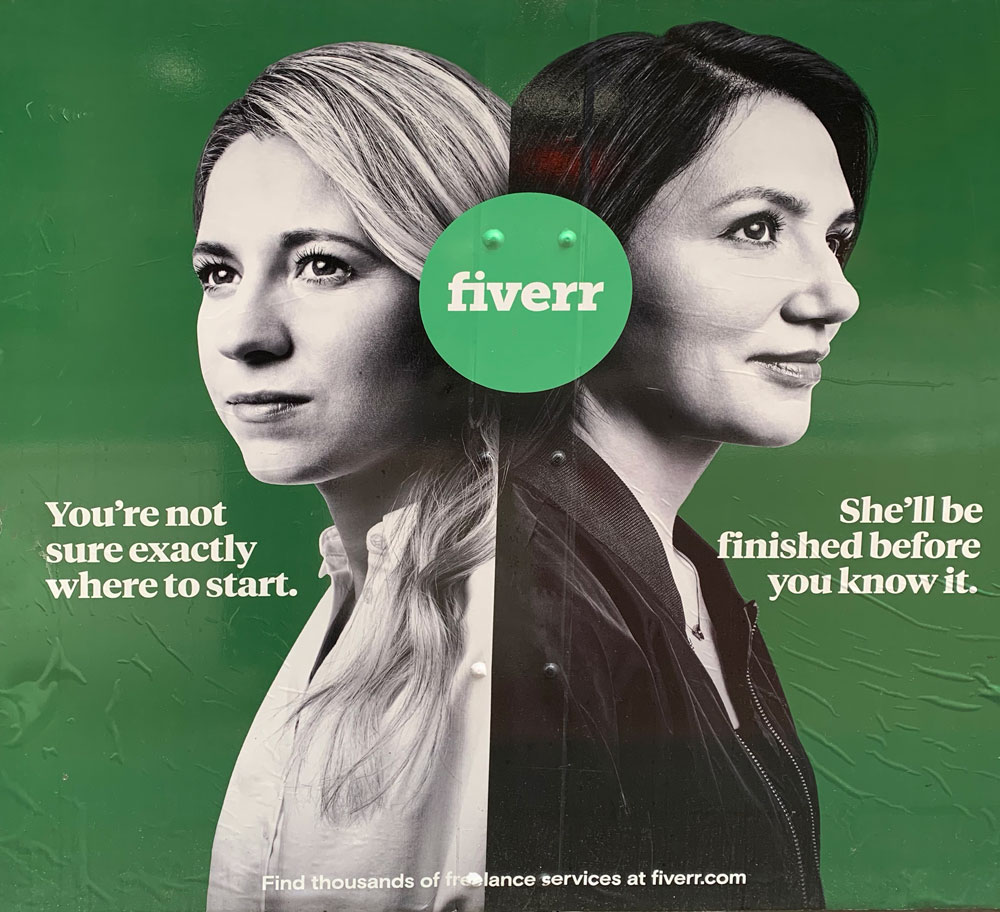05 Jun Buyer Beware: Fiverr and the Gig Economy
For the past year, I’ve been privileged to serve on the board of ico-D, the International Council of Design. Ico-D is a global umbrella organization for design associations around the world, and my own association, the Graphic Artists Guild, is a member. ico-D straddles cultural and political nuances while providing a forum for designers from around the globe to connect and work on issues that are common to all of us. So when I heard that ico-D was publishing an article on Fiverr and its toxic “gig economy” business model, I was intrigued to find out how they would address the subject.
For those who are unaware (or haven’t seen the advertisements plastered all over lower Manhattan), Fiverr is an online platform where individuals can offer their services at gutted prices – originally, as the name implies, $5. Fiverr had reached out to ico-D to see if the organization would be interested in a partnership to promote Fiverr’s educational platform, Fiverr Learn. Clearly, Fiverr didn’t understand who they were communicating with. Instead of blindly pursuing a partnership “opportunity”, ico-D’s response was to thoroughly research the company and post their findings.

Ico-D highlights the risk that buyers take when using Fiverr by peppering the article with quotes from complaints filed with the Better Business Bureau. The problems with Fiverr range from poorly executed designs, to plagiarized work, to a lack of communication between designer and client. The issue of plagiarized work is pervasive, but in their terms of use, Fiverr ducks any responsibility for copyright infringement. That means the unwitting business which purchases a plagiarized logo from Fiverr has no recourse if the copyright holder surfaces; the cost of removing the logo from all materials (marketing collateral, products, storefronts, stationery, etc.) and any legal fees have to be absorbed by the client. Should a client decide to cancel a project before its completed, Fiverr refuses to refund any fees, requiring the client to stay on the website and try their luck with another designer.
Ico-D points out that much of the problem with Fiverr lies with the gig-economy pricing model which pits designers in competition for lower and lower fees. According to ico-D’s assessment, many of the designers on the platform appear to be novices, software technicians, or untrained professionals working in developing countries. However, even then, Fiverr doesn’t offer a sustainable model, swallowing 20% of each transaction while encouraging designers to undercut each other. It’s a lousy business model for designers, but a lucrative one for Fiverr; in the nine years, since it was founded, the company’s value has grown to over $700,000.
What is so interesting about ico-D’s response to Fiverr is the sensitivity with which the organization addresses the differing reactions to their business model depending on the economic conditions of the participating designers. As a global entity, ico-D’s constituent associations include those in emerging economies where the low fees commanded by Fiverr designers may yield a livable wage. Gig economy and crowd-sourcing models are the bane of those associations, which recognize that those models will prevent wage growth in their economy, or drive wages lower. These associations work to raise professional standards and respect for copyrights – efforts that are undermined by companies such as Fiverr. Ico-D threads the needle by pointing out that Fiverr’s model is bad for design and bad for designers: “[It] does not meet international best practice standards for designers, users or the value of design in general.”
Rebecca’s headshot is by the amazing Caroline Kessler.

